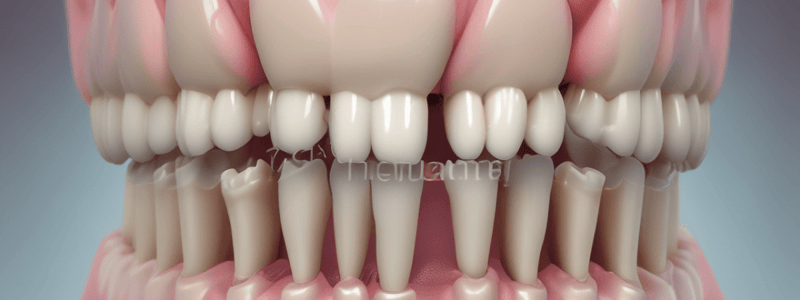Podcast
Questions and Answers
What is the main complication that arises due to the difference in mobility between a tooth and an implant?
What is the main complication that arises due to the difference in mobility between a tooth and an implant?
- Class 1 lever formation (correct)
- Implant fracture
- Restorative failure
- Bone loss
What is the result of a poorly fitting implant framework?
What is the result of a poorly fitting implant framework?
- Bone gain
- Mechanical complications (correct)
- Improved occlusal scheme
- Reduced microbial population
What is the consequence of an improper fit of abutment?
What is the consequence of an improper fit of abutment?
- Decreased microbial population
- Bone loss and rapid screw-joint failure (correct)
- Rapid screw-joint success
- Improved implant mobility
What is the guideline for infraocclusion in implant-supported restorations?
What is the guideline for infraocclusion in implant-supported restorations?
Why is it important to avoid balancing contacts on cantilevers?
Why is it important to avoid balancing contacts on cantilevers?
What is the relationship between occlusal table width and implant diameter?
What is the relationship between occlusal table width and implant diameter?
What is the consequence of an improper occlusal scheme?
What is the consequence of an improper occlusal scheme?
What is a sign of a failing implant?
What is a sign of a failing implant?
What is the first step in treating a failed implant?
What is the first step in treating a failed implant?
What is a possible cause of a failing implant?
What is a possible cause of a failing implant?
What is the purpose of radiographic evaluation in implant diagnosis?
What is the purpose of radiographic evaluation in implant diagnosis?
What is the significance of a 'dull' percussion sound in implant diagnosis?
What is the significance of a 'dull' percussion sound in implant diagnosis?
What is the primary concern when dealing with an improper occlusal scheme in implant restoration?
What is the primary concern when dealing with an improper occlusal scheme in implant restoration?
What is the primary concern when dealing with an improper fit of abutment in implant restoration?
What is the primary concern when dealing with an improper fit of abutment in implant restoration?
What is the recommended method to remove a fractured abutment screw?
What is the recommended method to remove a fractured abutment screw?
What is a common indication for removing a healing abutment?
What is a common indication for removing a healing abutment?
What is the likely cause of a loose bar?
What is the likely cause of a loose bar?
What is the recommended step after removing a fractured abutment screw?
What is the recommended step after removing a fractured abutment screw?
What is the goal of retorquing the abutment screw?
What is the goal of retorquing the abutment screw?
What is the recommended tool for tightening the abutment screw?
What is the recommended tool for tightening the abutment screw?
What is the likely diagnosis for a loose bar with poor seating of the abutment?
What is the likely diagnosis for a loose bar with poor seating of the abutment?
What is the recommended solution for a slightly sensitive but perfectly immobile implant?
What is the recommended solution for a slightly sensitive but perfectly immobile implant?
Why might an implant be painful and mobile?
Why might an implant be painful and mobile?
What could be the cause of difficulty inserting a transfer screw, gold screw, or healing cap?
What could be the cause of difficulty inserting a transfer screw, gold screw, or healing cap?
What might be the consequence of traumatic placement of an implant?
What might be the consequence of traumatic placement of an implant?
What is a possible solution for inability to perfectly connect the abutment to the implant?
What is a possible solution for inability to perfectly connect the abutment to the implant?
What is the solution for an implant that is slightly sensitive but perfectly immobile?
What is the solution for an implant that is slightly sensitive but perfectly immobile?
What is a possible cause of an implant being painful and mobile?
What is a possible cause of an implant being painful and mobile?
What is a possible consequence of traumatic placement of an implant?
What is a possible consequence of traumatic placement of an implant?
What is the recommended solution for an inability to perfectly connect the abutment to the implant?
What is the recommended solution for an inability to perfectly connect the abutment to the implant?
Study Notes
Complications in Implant Dentistry
- Pier abutments can lead to complications due to differences in mobility between teeth and implants, resulting in two situations: implant as pier (acting as a class 1 lever) or tooth as pier (acting as a living pontic or pontic with a root).
Etiology: Restorative Factors
- Lack of passive fit between the framework and underlying fixtures can cause mechanical complications, such as loose screws or fractured components.
- Improper fit of abutment-fixture interface can lead to increased microbial population, bone loss, and rapid screw-joint failure.
- Improper occlusal scheme can cause complications; guidelines to follow include:
- Infraocclusion up to 30 microns of implant-supported restoration
- No balancing contacts on cantilevers
- No guidance on single implants
- Freedom in centric
- Occlusal table directly proportional to implant diameter
- Narrow occlusal width
Fractured Abutment Screw
- Treatment involves:
- Unscrewing the fragment with an explorer
- Replacing with a new abutment and screw
- Verifying seating with a radiograph prior to final torque
- Replacing the prosthesis and securing with new retention screws
Loose Healing Abutment
- Radiographic evaluation is necessary
- Treatment involves replacing the healing abutment
Loose Bar
- Radiographic evaluation confirms poor seating of the abutment
- Clinical evaluation after removal of the bar indicates a loose abutment screw
- Treatment involves:
- Retorqueing the abutment screw
- Replacing the bar and torquing prosthetic screws
Loose Restoration
- Radiographic evaluation reveals a small opening at the abutment-implant interface
- Treatment involves:
- Loosening the screw and removing the restoration
- Inspecting the implant hex for damage
- Inspecting the restoration for damage
- Replacing the restoration and securing with the same screw or a new screw
Fixture Loss
- Failing implant: clinical signs include progressive bone loss, soft tissue pockets, bleeding on probing, tenderness to percussion or torque forces
- Causes of failing implant: overheating of bone during surgery, lack of initial stability, inadequate screw joint closure, functional overload, periodontal infection
- Treatment: remove prosthesis and abutments, irrigate with Peridex, ultrasonically clean and disinfect components, reinsert with proper screw torque, recheck passive fit of framework and occlusion
- Failed implant: clinical signs include mobility, dull percussion sound
- Treatment: remove the implant
Studying That Suits You
Use AI to generate personalized quizzes and flashcards to suit your learning preferences.
Related Documents
Description
Learn about the complications of pier abutments in dentistry, specifically the differences in mobility between teeth and implants, and how they relate to class 1 levers.





